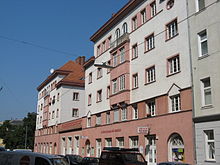Hasengasse
| Hasengasse | |
|---|---|
| Street in Vienna-Favoriten | |
| Basic data | |
| place | Vienna favorites |
| District | Favorites |
| Created | 1862 |
| Cross streets | u. a. Laxenburger Strasse , Leebgasse , Neilreichgasse |
| Buildings | Pölzerhof |
| use | |
| User groups | Foot traffic , car traffic |
| Technical specifications | |
| Street length | approx. 780 meters |
The Hasengasse located in the 10th Vienna district , favorites . It was named in 1862 after hare hunts in this area that continued until 1850 on the so-called hare field . The area was incorporated into Vienna in 1850, until 1862 it belonged to the 4th district, Wieden , and from 1862–1874 to the then newly established 5th district, Margareten . In 1874 it was incorporated into the new 10th district.
Location and characteristics
At the foot of the Wienerberg, Hasengasse stretches from Laxenburger Strasse in the east in a straight line for ten blocks to Sonnleithnergasse in the west. The alley, which runs roughly parallel to Gudrunstraße , mostly a block north of it, and in which there is no public transport, is run as a one-way street .
The densely built-up Hasengasse with residential houses, built from the end of the 19th century, touches the green area of the Waldmüllerpark , where the Matzleinsdorf Catholic Cemetery was once located outside the Matzleinsdorfer line . The Hasengasse gained a certain fame as the setting for the television series “ A real Viennese does not go under ” (1975–1979).
building
No. 35–37: Urban residential complex
Between Herzgasse and Neilreichgasse there is an urban residential complex that was built in 1926 according to plans by Georg Rupprecht. The facility consists of a U-shaped structure around a wide street courtyard on Hasengasse with a low gate wing. Horizontal plaster and clinker strips as well as cornices emphasize the block-like character of the building, while corner windows contribute to the dynamism of the facades. The individual components are of different heights, the main wing comprises six floors. Original lampposts and gate grilles have been preserved in the courtyard. There are a total of 176 apartments in the complex. A plaque from 1952 commemorates the resistance fighters Franz Kalis , Karl Kriwanek and Johann Sokopp .
No. 38–42: Pölzerhof
Opposite the abovementioned residential complex between Dampfgasse and Hasengasse is the Pölzerhof urban residential complex . It was built at the same time from 1926 to 1927 according to plans by Hugo Mayer . The complex, comprising 103 apartments, consists of a block perimeter construction around a small inner courtyard, while a lower single-storey component opens the facade on Hasengasse. This is where the Waldmüllerzentrum is located , where exhibitions from the Favoritner district museum and concerts take place, as well as a branch of the Vienna libraries .
literature
- Herbert Tschulk: Viennese district culture guide favorites . Jugend & Volk, Vienna 1985, ISBN 3-224-16255-4
- Felix Czeike : Historisches Lexikon Wien , Volume 3. Kremayr & Scheriau, Vienna 1994
- Bundesdenkmalamt (Ed.): Dehio-Handbuch Wien. X. to XIX. and XXI. to XXIII. District . Anton Schroll, Vienna 1996
Web links
Coordinates: 48 ° 10 ′ 46 " N , 16 ° 22 ′ 6.6" E


